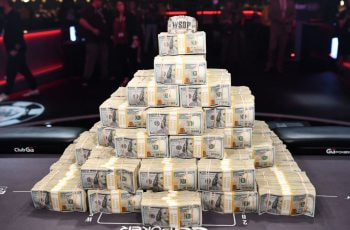Henry Orenstein, the Hole Cam Creator, Has Died Aged 98
1995 World Series of Poker main event eighth-place finisher Henry Orenstein has died aged 98. The Polish-American Holocaust Survivor was best known as the creator of Transformers toys – the most successful action figures in history. They sold in the millions during the 1980s and spawned equally successful TV shows, movies and lines of merchandise.
In modern poker circles, Orenstein was considered a founding father. In 1995 he was granted a patent by the United States Patent and Trademark Office for a groundbreaking under-the-poker-table hole-card camera.
Better known as the simple ‘hole cam’, the device helped revolutionize poker by bringing the game to an enormous global audience. Late Night Poker, the British TV series that initially aired on Channel 4 in 1999, was the first to adopt it.
Hall of Famer
At the tables, Orenstein won a World Series of Poker gold bracelet when taking a $5,000 Seven-Card Stud tournament at the 1996 Series.
Eight years later Orenstein was the creator and an executive producer of the Poker Superstars Invitational Tournament. It was broadcast in the United States on Fox Sports and ran for three years.
In 2008, with the poker community thankful for the popularity his under-the-table hole-card camera and television show had brought the game, he was inducted into the Poker Hall of Fame.
The Boom Begins
Henry Orenstein eventually held over 100 patents in total. But sadly for him, he did not have claims on any other poker-related ideas and concepts.
The late 1990s was a gold rush for poker. The floodgates truly opened on January 1st, 1998, when the first hand of online poker was played.
Nine months later, Rounders, staring the Matt Damon and Edward Norton was released in movie theatres. A slow burner, by the mid-2000s, when poker was at the height of its boom, it had achieved cult status.
1999s Late Night Poker – using Orenstein’s under-table cameras – elevated the game further. Despite the UK’s population being considerably smaller than that of North America, and given a graveyard mid-week slot on Channel 4, the final table of the first series still attracted an audience in excess of one million viewers.
Making Money
The final piece in the jigsaw was Chris Moneymaker’s success in the 2003 World Series of Poker Main Event. His name was a headline grabber and his success secured mainstream nationwide media coverage.
Furthermore, the 27-year-old restaurant employee from Tennessee had won his seat in the tournament via a new concept, an online satellite.
PokerStars, the online poker room where the champion’s journey had begun, quickly signed up his services as a brand ambassador. They marketed the player and his story exceptionally well.
Still talked about today and known as the Moneymaker Effect, the planets lined up perfectly to make poker a flourishing mainstream sport and pastime played both live and online.
The global online gambling market is projected to be worth more than $92.9 billion in 2023. Remarkably, online poker currently accounts for 18.7 percent of that worth. It is predicted to have a 19.1 percent share by 2027.





